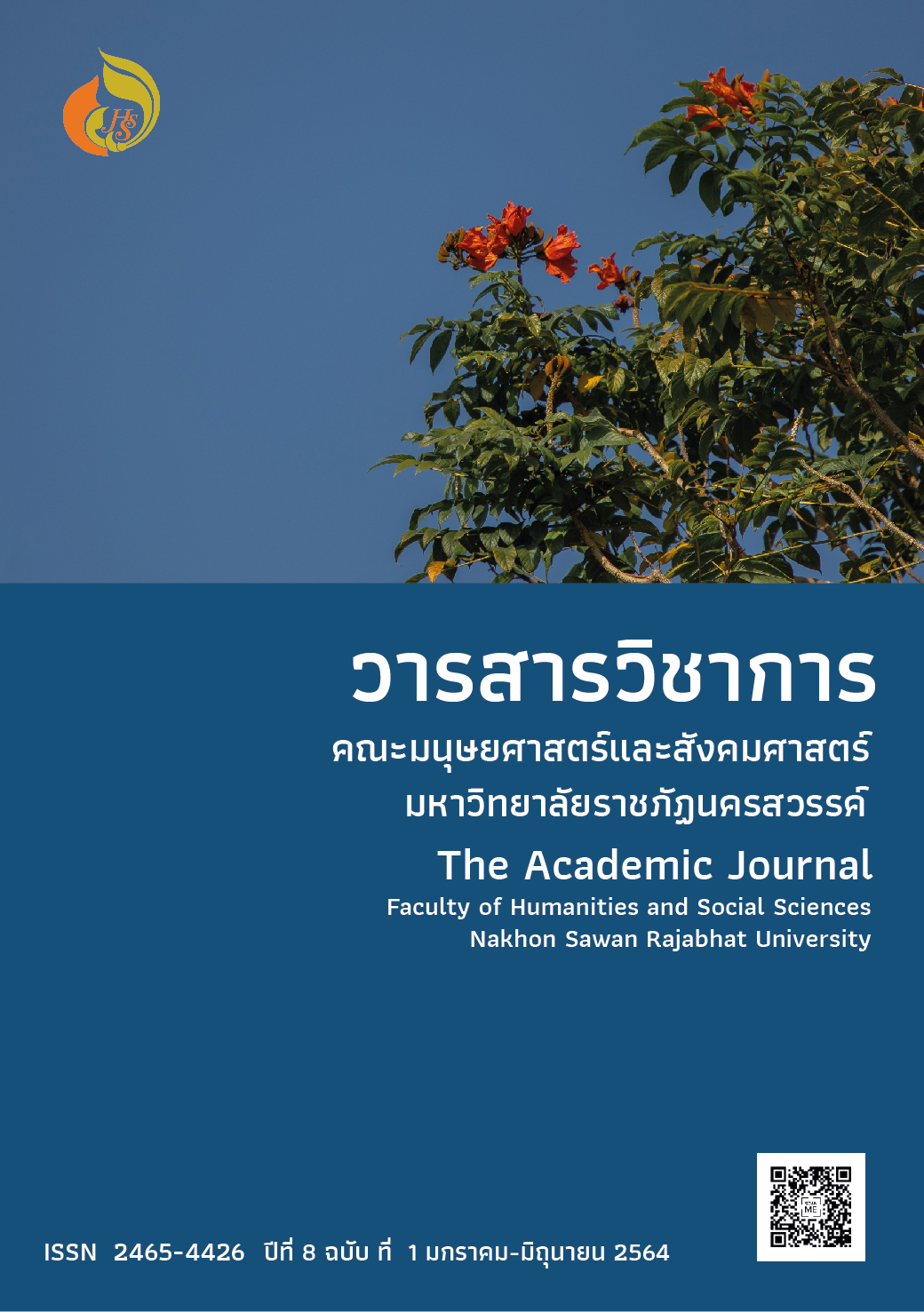Slang reprimanding on Twitter
Main Article Content
Abstract
On Twitter, though massages are tweeted in limited number of words each time, with more freedom of communication than other online media, a lot of harsh words have been posted, especially the reprimand. Hence, slangs are used to communicate in order to avoid the straightforward use of ordinary reprimanding words.
This article is a part of research “Slang on Twitter: The Reflex of Thai Society”. There are two part of research’s purposes: 1) function of Slang and 2) the reflex of Thai Society”. One of function is reprimanding.
Slang reprimanding on Twitter is divided into three groups: 1) Specific slang is a slang word that is made exclusively, not used in common language, and understood by only group of users. For example, “bong” means failure. 2) General slang is a general communication word but it has been changed to the other meaning still linked to the original meaning. For example, “dinosaur” means conservative people, “longan” means annoyed. 3) Artificial slang is a slang word modified from a general word to have a different word formation from its origin. No matter to define a new meaning or not, both the form and the new meaning are still connected with the original form and meaning. It is divided into 3 sub-categories, including using abbreviations such as "E.H." means E Hah, E Hia, E Hoghug, using spoonerism word such as "Dee Og” means EE Dok and using prank word divided into 4 ways: pronunciations, syllables, intonations, and spelling differing from original words. For example, "I Hiam" comes from the word "I Hia" and "I Sus" comes from the word "I Sut".
The studies showed that there are several ways to create slang on Twitter but with same purpose to reprimand society and individual involved in social activities. In addition, the use of slang also avoids the straightforward reprimanding words which risks breaking the law.
Article Details

This work is licensed under a Creative Commons Attribution-NonCommercial-NoDerivatives 4.0 International License.
References
คู่มือการเล่น Twitter ฉบับคนเล่น Facebook เห็นแล้วไม่งง เข้าใจใน 10 นาที. สืบค้นเมื่อ 28 มีนาคม 2564, จาก https://www.mangozero.com/how-to-use-twitter-for-facebook-user/
จินตนา พุทธเมตะ. (2546). คำสแลง. กรุงเทพฯ: ภาควิชาภาษาไทยและภาษาตะวันออก คณะมนุษยศาสตร์ มหาวิทยาลัยศรีนครินทรวิโรฒ.
ชลธิชา จันทร์ขาว, อนันต์ อารีย์พงศ์ และจริญญา ธรรมโชติ. (2562). การใช้คำแผลงภาษาเขมรในการสร้างสรรค์วรรณศิลป์ในแบบเรียนวรรณคดีวิจักษ์ชั้นมัธยมศึกษา. สารอาศรมวัฒนธรรมวลัยลักษณ์, 19(1), 122-134.
ดวงพร รื่นเรืองฤทธิ์ และ Huang Guamei. (2561). ภาพสะท้อนชีวิตรักและการแต่งงานของชาวจีนผ่านคำสแลงในแต่ละยุค. วารสารวิจัยราชภัฏกรุงเก่า, 5(1), 87-94.
นันทา อาจแย้มสรวล. (2531). การศึกษาลักษณะภาษาไทยในวารสารเพื่อการท่องเที่ยว ปี พ.ศ.2524 (วิทยานิพนธ์ปริญญามหาบัณฑิต). กรุงเทพฯ: จุฬาลงกรณ์มหาวิทยาลัย.
บุญยงค์ เกศเทศ. (2537). คำไทย. กรุงเทพฯ: โอเดียนสโตร์.
เบญจรงค์ ถิระผลิกะ. (2560). ชายรับชาย: ความสัมพันธ์ของชุมชนบนทวิตเตอร์. วารสารวิชาการนวัตกรรมสื่อสารสังคม, 5(2), 69-80.
ผะอบ โปษะกฤษณะ. (2541). ลักษณะเฉพาะของภาษาไทย. พิมพ์ครั้งที่ 6. กรุงเทพฯ: มปท.
ราชบัณฑิตยสถาน. (2525). พจนานุกรม ฉบับราชบัณฑิตยสถาน พ.ศ. 2525. (พิมพ์ครั้งที่5). กรุงเทพฯ: อักษรเจริญทัศน์.
ราชบัณฑิตยสถาน. (2546). พจนานุกรมฉบับราชบัณฑิตยสถาน พ.ศ. 2542. กรุงเทพฯ: นานมีบุ๊คส์พับลิเคชั่นส์.
ราชบัณฑิตยสถาน. (2554). เฉลิมพระเกียรติพระบาทสมเด็จพระเจ้าอยู่หัว เนื่องในโอกาสพระราชพิธีมหามงคล เฉลิมพระชนมพรรษา 7 รอบ 5 ธันวาคม 2554. กรุงเทพฯ: นานมีบุ๊คส์พับลิเคชั่นส์.
รุ่งอรุณ ทีฆชุณหเถียร. (2529). ที่ว่าหยาบนั้นฉันใด. วารสารมนุษยศาสตร์และสังคมศาสตร์, 5(2), 110-119.
วิชาติ บูรณะประเสริฐสุข. (2545). ลักษณะภาษาสแลงของผู้ต้องขังและความสัมพันธ์ระหว่างบุคลิกภาพและสติปัญญาของผู้ต้องขัง กับพฤติกรรมทางภาษา: ศึกษากรณีเรือนจำกลางคลองเปรม (วิทยานิพนธ์ปริญญามหาบัณฑิต). กรุงเทพฯ: มหาวิทยาลัยธรรมศาสตร์.
วิไลวรรณ ขนิษฐานันท์. (2526). ว่าด้วยสแลง. ภาษาและภาษาศาสตร์, 1(1), 29-39.
วิสันต์ สุขวิสิทธิ์. (2547). วัจนกรรมการบริภาษในภาษาไทย (วิทยานิพนธ์ปริญญามหาบัณฑิต). กรุงเทพฯ: จุฬาลงกรณ์มหาวิทยาลัย.
สมโรจน์ สวัสดิกุล ณ อยุธยา, ท่านผู้หญิง. (2526). “ข้อคิดเห็นบางประการเกี่ยวกับภาษาไทย” สิ่งน่ารู้ในภาษาไทย.
สอ เสถบุตร. (2524). New Model English-Thai Dictionary. กรุงเทพฯ: มปท.
สุชาดา เทวะผลิน. (2531). คำสแลงในภาษาไทยจากหนังสือพิมพ์รายวัน (วิทยานิพนธ์ปริญญามหาบัณฑิต). กรุงเทพฯ: จุฬาลงกรณ์มหาวิทยาลัย.
สุดาพร ลักษณียนาวิน. (2525). ภาษาศาสตร์กับครูสอนภาษา. ศาสตร์แห่งภาษา, 1 (พฤษภาคม 2525).
อมรา ประสิทธิ์รัฐสินธุ์. (2522). สมมติฐานซาเพียร์-วอร์ฟ. วารสารอักษรศาสตร์, 11(2), 20-33.
อรรถวิทย์ รอดเจริญ. (2552). การศึกษาการใช้ภาษาบริภาษของนักการเมืองไทย (วิทยานิพนธ์ปริญญามหาบัณฑิต). กรุงเทพฯ: มหาวิทยาลัยเกษตรศาสตร์.
Brown, P. & Levinson, S. C. (1987). Politeness: Some universals in language usage. Cambridge: Cambridge Press.
Fowler, H. W. (1965). A Dictionary of Modern English Usage. Oxford: Clarendon Press.
Harris, R. T., & Jarrett, J. L. (1956). Language and informal logic. New York: Longmans.
Hawkins, J. M., & Allen, R. (1991). The Oxford Encyclopedic English Dictionary. Oxford: Clarendon Press.
Searle, J. R. (1969). Speech acts: An essay in the philosophy of language. Cambridge: Cambridge University Press.


